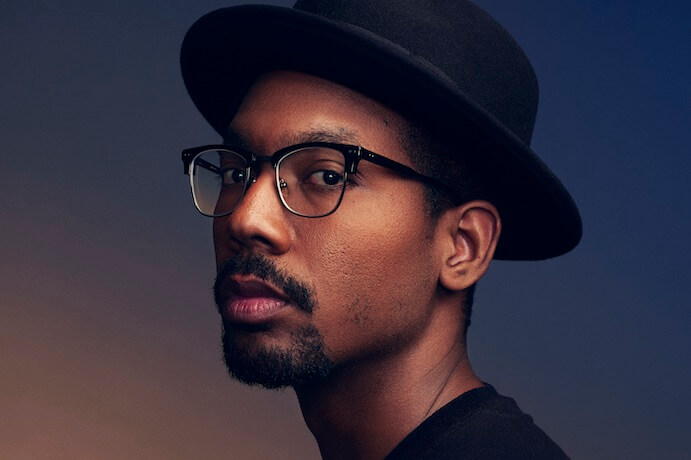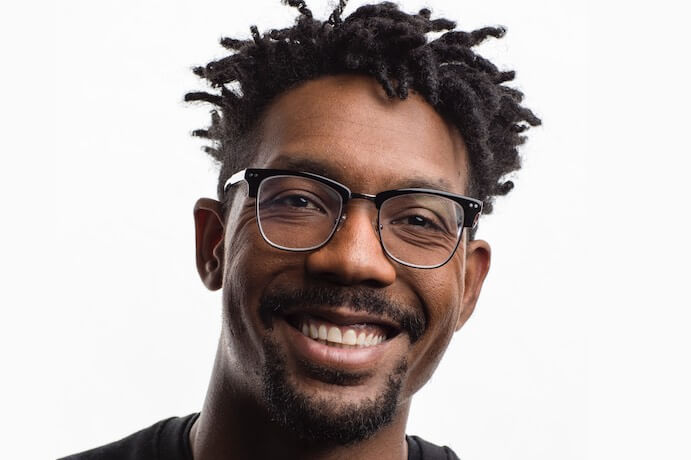Social commentary, elements of mythology, and the creation of Black joy are themes that are present in the work of post-disciplinary artist Damon Davis. His work questions who gives and receives power in our society, and how that continues to impact our world. Davis’ activism helps to inspire his community to create radical systems for social change and justice. Damon is one of the recipients of the 2021 Matt Marks Impact Fund Award from Alarm Will Sound to create Ligeia Mare, a “science fiction electronic fantasy opera.”
Ligeia Mare is inspired by the biography of legendary Jazz musician Sun Ra. Can you speak to Sun Ra’s influence on the opera and how his work impacted you as an artist?
The initial inspiration for Ligeia Mare was the life and philosophy of jazz innovator and legend Sun Ra. His music and mythology blew me away when I first discovered him over a decade ago. I found a kinship in the way he dealt with the “other” that Black people find ourselves existing as here in the United States. When the first sparks of this project emerged, it was from listening to his music as well as learning about his philosophies and visual aesthetic. His dedication to the mythology, his philosophy about mythology and its relationship to the image of Black people in America, and his unwavering commitment to constant experimentation were all influential in my decision to make the method for telling this story an opera specifically. Events in Ra’s life also resonated with experiences I have had, and I was thus inspired to write Ligeia Mare, a fictional story about a child that travels the stars in his dreams.
Sun Ra has also been a huge influence on my work at large and on hip-hop production in general. Furthermore, people who Sun Ra influenced, have influenced me such as Madlib and other hip-hop producers. One big thing for me is Sun Ra’s lecturing at Berkeley and his movie Space Is the Place. In the latter, he expands on his idea around the myth; he’s an alien, and he’s talking to the Black youth of that time. This was in the 70s–a militant time and the heyday of the Black Power struggle–and he’s telling them, “You are a myth. Black people are a myth. You don’t have a nation. You don’t have a flag. You don’t have anything that makes you real, and other people dictate who you are, so you’re a myth.” Hearing that was really influential in me describing and reaffirming my work as mythology. I had never thought of Blackness as a myth until I rewatched that film. Understanding that also means that everything that’s not tangible is a myth, so if Black people are a myth, then so are white people, but then you think about what’s the separation between the two and it’s power. People in power are able to control narratives and thus what mythologies societies believe, including Blackness. This ties into my work in a larger sense, as I explore how identity is informed by mythology and story. Through my work, I use mythology to create a conversation around how we see ourselves and others.
Lastly, I have always been inspired by Sun Ra’s persona and Sun Ra as a character. In watching Sun Ra: A Joyful Noise, which documented performances by Sun Ra and his Arkestra, you can really see his power as a leader and his great ability to build community around himself, and around an idea. This was super inspirational to me because you see that he’s inventing a story and he’s getting other people to believe in it, too. Then they’re adding to the story, so he’s not just the only author of that story. If you can do that, you have created a myth–something bigger than you that’s going to outlive you, a communal idea and identity. Understanding his process has definitely influenced my work.

Damon Davis–Photo courtesy TED
Cosmo, the character around which Ligeia Mare is based, has special powers that allow him to escape reality and go to his own dream world. How do you see yourself reflected in Cosmo?
Growing up, I used art to escape. My parents wouldn’t let me wander around and explore, and I grew up on a dead end street at the edge of East St. Louis, so I spent a lot of time in the house making up stories, writing, drawing, and watching TV. I always felt awkward as a kid and had my own insecurities around not belonging. I often felt like I fell from somewhere else, and I used to say that as a kid. I felt like I never quite fit in. Although it wasn’t necessarily my intention to make Cosmo’s character autobiographical, my personal experiences end up shaping many characters in these stories; they are influenced by one facet of myself or another, or they explore a period of my life and then I build out from there. Everything I make has pieces of me inside of it. It’s impossible to create if you don’t use yourself in your work. It takes a lot of vulnerability, but that is what it takes to be an artist.
For Ligeia Mare and Cosmo specifically, I definitely still view my art as my spaceship or my superpower that allows me to escape. As I mentioned above, art was especially important in terms of escaping my environment when I was a child. Other family dynamics also find their way into the story. When I moved over to St. Louis and became involved in the underground music and art communities, I met other Black artists who are similarly weird and non-mainstream, I really felt like I found my people. We started to share influences and build together, which led to the creation of my music label FarFetched over ten years ago. My finding of community through music and art here could also be viewed as paralleling Cosmo’s journey of self discovery.
You work extensively in both digital and physical media, but is there a medium that you have yet to explore and hope to engage with in the future?
I would say the media I engage with is pretty wide ranging already, but I have yet to write a novel and hope to do so one day.
In the past, you have created various works that support social movements. Are you currently working on anything that responds to our current political and social climate?
I make work about the world around me and the things that are important to me, so everything I do is a reflection of the current political and social climate, because I live inside that climate. I don’t always go in with an agenda to create something specifically to talk about these aspects of society, but if it’s on my mind, it will find its way into the work.
I also believe that the climate we are in now is the same one that we were in 10 years ago, 20 years ago, 50 years ago, etc. White people tend to forget when there’s a bigger moment and then things go back to “normal,” but everything that we’re facing now, Black people have been dealing with for hundreds of years.
My work is rooted in the Black American experience because that is my experience. I am motivated by how I internally process the idea of race and how it has personally affected my life, as well as the larger socio-political implications of race in America and the world. I explore this concept from the place of an artist that sees the importance of lending his talents to help liberate, emboldened, and protect Black people and culture through the stories I tell. I also use the theme of identity to critique the cultural norms and practices of Black America and the tropes thrust upon us by the status quo, as well as the trauma that comes with everyday life.
In this way, my work is always responding to current climates because it is always influenced by my experiences living as a Black person in this country. It’s a current moment for some, but it’s my entire life for me, so I’m not sure what else to say about the framing of this particular climate.
Damon Davis–Photo courtesy TED
What do you hope is different about the world because of the existence of your work?
Primarily, I hope I leave the world with more light in it than when I found it. I hope people get something out of my work, and that they see themselves and see the world both as it is and as it could be.
For me personally, my work is often more about the process of making than the final product. Through my process, I am working through things trying to find some peace, trying to become whole. In this way, my work has always been part therapy, part social commentary.
My work seeks to empower the disenfranchised and powerless, and to combat the systemic oppression that plagues our world today. In the past, I have created work that brought people together and fortified the souls of the people in the most pain and the most struggle. Now I make work that not only focuses on pain, but also on the joy of those people. Through my work, I am having a conversation with myself. When that conversation is made public, my hope is that people can see themselves in my work and it helps them grow, along with myself.
My hope for this opera specifically is to encourage Black kids to recognize they actually do have some control over their lives and that there are other people out there who are like them. Whoever the viewer is, both adult and child, I hope my stories provide some kind of empowerment, and you feel for these characters, and you can see yourself in them. Ultimately, if I tell a story well enough, there will be things people get out of it that I could never anticipate. I hope I make something that big, that’s a real myth, that can be interpreted in multiple ways, and multiple types of people can continuously take some kind of lesson out of it and find some kind of nutrition for their souls.
I CARE IF YOU LISTEN is an editorially-independent program of the American Composers Forum, funded with generous donor and institutional support. Opinions expressed are solely those of the author and may not represent the views of ICIYL or ACF.
A gift to ACF helps support the work of ICIYL. For more on ACF, visit the “At ACF” section or composersforum.org.

